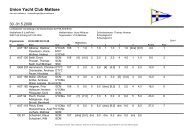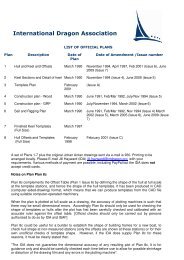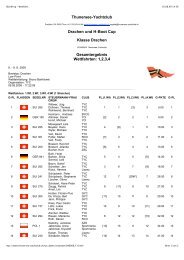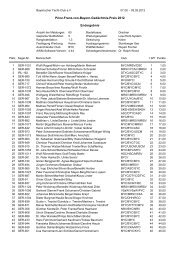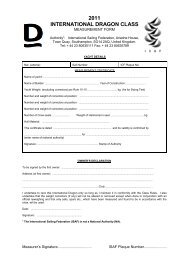Annual General Meeting 2008 (pdf) - International Dragon Association
Annual General Meeting 2008 (pdf) - International Dragon Association
Annual General Meeting 2008 (pdf) - International Dragon Association
You also want an ePaper? Increase the reach of your titles
YUMPU automatically turns print PDFs into web optimized ePapers that Google loves.
The strength of our Class and it’s standing on the <strong>International</strong> stage, continued to be<br />
maintained. Major events attract very large high quality fleets. The challenge for the National<br />
Organizations is to encourage growth at country level as the <strong>International</strong> and travelling fleet<br />
is well catered for by a Rota of events at a range of interesting venues.<br />
7. Technical Committee Chairman’s Report<br />
After the introduction of the rules concerning buoyancy last year we have seen the builders<br />
introducing the measures to meet the new requirements and I believe that these have been<br />
successful. I witnessed the inclination test on the Petticrow <strong>Dragon</strong> and Gunter Ahlers went<br />
to Denmark to see the test on the Royal Denship <strong>Dragon</strong>. I must emphasize that even with<br />
the improved buoyancy the boats will sink unless they are sailed with the hatches closed.<br />
With regard to this year’s rule changes, those submitted by the Technical Committee are in<br />
essence clarifications and I commend them to you as a package.<br />
There are two changes proposed by Antigua, one concerning the size of the Jib and the other<br />
allowing spectra to be used instead of wire for the runners and backstay.<br />
You will all have seen the comments by the Technical Committee on these two issues but I<br />
set them out again for you.<br />
Rule 9.41 Jib<br />
A small jib has always been allowed in the Class Rules but in practice it has not been used in<br />
recent years. Previously when it was used, it was not considered to be effective, because<br />
probably the courses sailed were Olympic triangles with reaches, whilst now the courses are<br />
mainly windward leeward courses so in heavy airs it might be efficient particularly as it is<br />
proposed to have a more efficient profile.<br />
The nominal size of the old jib was 5.99sq metres and the new proposal is 6.63sq metres, an<br />
increase of 12% (Antigua asked for 5.78 sq metres, slightly smaller than the existing rule but<br />
a better profile)<br />
There will be a cost increase for the Class, by the way of extra deck gear for sheeting the jib(<br />
€150) plus the cost of a new sail (€ 500), which should last considerably more time than our<br />
current heavy weather genoas.<br />
There will be a need to develop techniques for changing sailing during a race. In the old<br />
days the change was easier because the boats used hanks to attach the jibs and genoas to<br />
the forestay.<br />
It would certainly make the boat more manageable when sailing in heavy airs, particularly as<br />
the visibility for the helmsman would improve considerably.<br />
One way of looking at this change is that one design nature of the Class will change, one<br />
could have on the same course some owners sailing with genoas and others with jibs which<br />
will point higher because the narrower sheeting base. This pointing as well as tacking ability<br />
would be very beneficial for sailing on rivers such as the Crouch at Burnham.<br />
IDA AGM Minutes 7




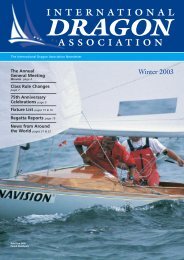

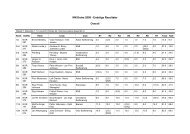
![PP Dragon Gould Cupver 4 [Mode de compatibilité] - International ...](https://img.yumpu.com/35317714/1/190x135/pp-dragon-gould-cupver-4-mode-de-compatibilitac-international-.jpg?quality=85)

